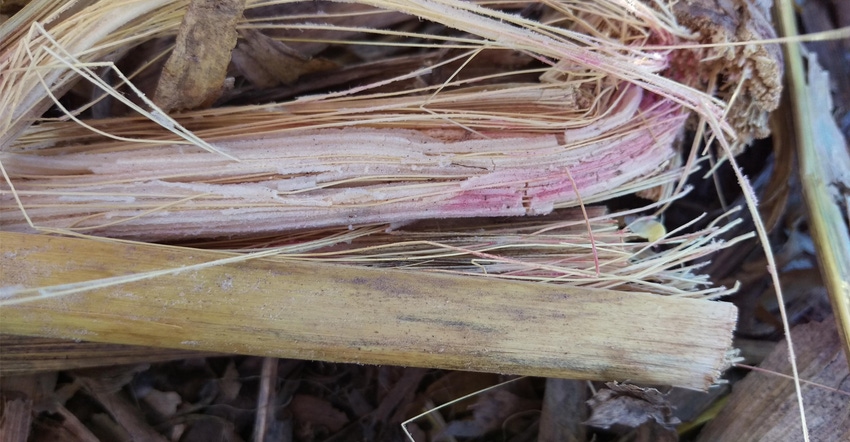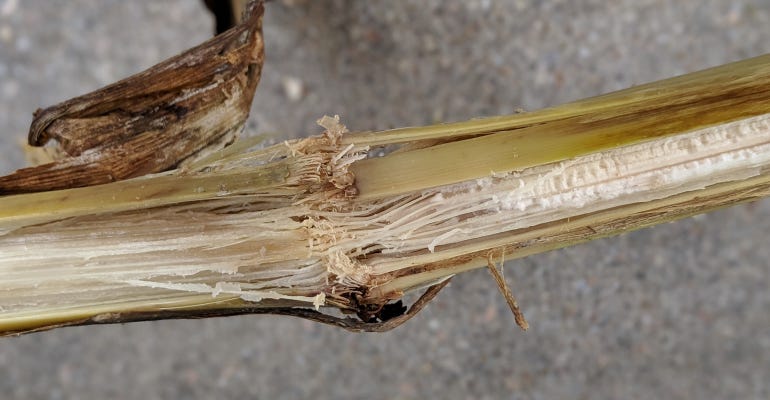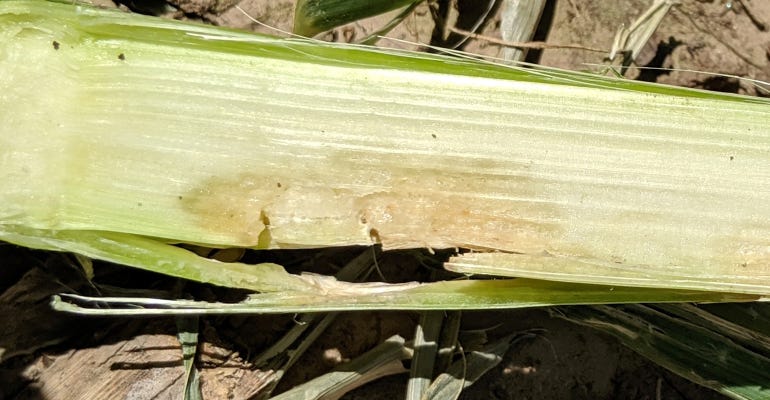September 5, 2019

By Jenny Rees
This year has been a challenge for crop growers and livestock producers. The cool, wet and cloudy conditions, in addition to hail damage, are allowing for increased late-season disease and environmental problems.
Stalk rot can occur for several reasons, including loss of leaf area because of diseases and hail; excessive rainfall and ponded soils; stalks wounded by hail and insects; and higher plant populations resulting in thinner stalk diameters.
As we approach harvest, it will be important to assess fields for potential stalk rot. This aids in planning which fields may have the greatest potential for lodging due to stalk rot and should be prioritized for harvest.
Evaluating percent stalk rot
At least 100 plants throughout the field should be assessed using either the "pinch test" or the "push test" to evaluate for potential stalk rot. I prefer the "pinch test" and do this by taking my thumb and first finger and pinching the stalk internode that occurs between the lower nodes above the soil line.
Do this for 20 plants in an area and get a percentage for those that crush. Then do this for several areas of the field. This YouTube video helps show how to do this: www.youtube.com/watch?v=7z75VN1c51Q.
Some prefer being able to stand and push stalks instead. To do the "push test," you can push the plant tops away from you about 30 degrees from vertical. If plants don't snap back to vertical when released, the stalk may have been compromised by stalk rot disease. Fields that have the greatest percentages of stalk rot before harvest may be prioritized over others.

WATER-SOAKED: Bacterial stalk rot occurs primarily as a result of wet growing seasons, saturated soil conditions and in hybrids that are more susceptible. Symptoms include water-soaked nodes and below the nodes with plants breaking off or falling over. Damaged nodes are found from the soil line to the upper canopy.

Currently in fields
What we're currently seeing in some fields is leaf discoloration, rapid plant wilting, plant lodging and even premature death of plants. These can be indications of stalk rot symptoms. Not all problems are originally caused by pathogens, as problems could be due to environmental conditions.
However, stressed plants can lead to pathogens invading and causing stalk rot at some point. There also are situations where hailstones have damaged stalks. Splitting open some hail-damaged stalks can help determine if stalk rot is setting in where hailstones hit stalks.
In mid-August, we already were seeing death of plants because of bacterial stalk rot. This was concerning, seeing anywhere from 1% to 15% stalk rot that early in the season. Bacterial stalk rot occurs primarily as a result of wet growing seasons, saturated soil conditions and in hybrids that are more susceptible.
The bacteria can infect at any node at either the bottom or top of the plant. Symptoms include water-soaked nodes and below the nodes with plants breaking off or falling over. Damaged nodes are from the soil line to upper canopy. This bacterial rot has a distinct foul smell, and the bacteria doesn't typically transfer from plant to plant.
Yellow or red tops in corn plants that contain ears and are turning yellow from the top to the middle of the plant can be occurring because of anthracnose top dieback or another disorder called "top leaf death or dieback in corn."
Anthracnose can cause leaf lesions, top dieback or stalk rot. To diagnose if anthracnose is the culprit, look for black fungal anthracnose lesions that may be blotchy in appearance on the stalk underneath the leaf sheaths.
You also can split the upper or lower stalk looking for any discoloration in the pith or nodes. If you don't see the lesions or pith or node discoloration, the discoloration in the top of the plant may be because of environmental or hybrid characteristics as grain fill progresses.
Fusarium and Gibberella stalk rots were especially common during the 2018 harvest season. Both the Fusarium and Gibberella pathogens are fungal; can live in residue; and create white, pink to salmon, or red discoloration at stalk nodes and inside the stalk pith.
One of the more common Fusarium stalk rot symptoms is the development of crown rot where the roots attach to the stalk below the soil line. More common symptoms of Gibberella stalk rot are weakening and breaking of the stalks at nodes and tiny black fungal structures on the stalk surface that can be scratched off.

HAIL DAMAGE: After this year's hail events, there also are situations where hailstones have damaged stalks. Splitting open some hail-damaged stalks can help determine if stalk rot is setting in where hailstones hit stalks.

Management considerations
Some seed companies provide hybrid ratings for a few stalk rot diseases aiding in selection of resistant hybrids. Using practices that minimize stress such as proper fertility, reduced seeding rates, and insect or disease control also may reduce incidence of stalk rot diseases.
The best way to minimize loss because of potential lodging is to assess percent stalk rot in each field and to harvest fields most affected first. Where it worked in their operations, some growers in 2018 chose to harvest at a higher moisture content in order to get at fields in a more timely manner.
For more information, see Corn Disease Profiles II: Stalk Rot Diseases or Common Stalk Rot Diseases of Corn.
Rees is a Nebraska Extension educator.
You May Also Like




